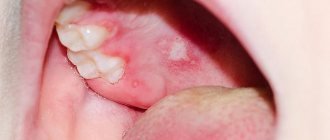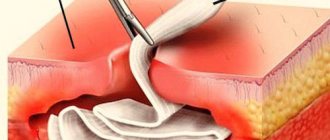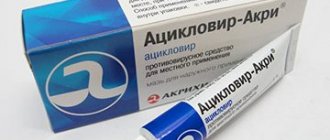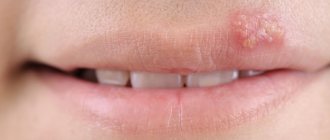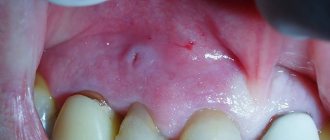Why did herpes appear on the gums?
For the virus to make itself felt, two things are enough: its presence in the blood and a weakened immune system.
Infection occurs by airborne droplets and can be transmitted from mother to child. Unfortunately, once you become infected with herpes, you can no longer get rid of it. But you can prevent its activation.
So, after infection, virus particles settle in the body forever. Most of the time the virus does not manifest itself in any way. What factors provoke the manifestation of the virus on the gums? Stress, including sudden nervous shock, chronic depression and fatigue, colds, bacterial and viral diseases, hypothermia, autumn or spring hypovitaminosis. A common cause of the appearance of “bubbles” characteristic of this disease is acclimatization. Are you familiar with the situation when the disease manifests itself on vacation, when changing time zones? Therefore, when planning trips, it is better to immediately stock up on antiviral drugs and ointments.
How to recognize herpes
The difficulty is that the symptoms of herpes in the mouth are easily confused with the manifestation of stomatitis and other diseases of the oral mucosa.
Differences:
- as a rule, stomatitis affects a larger area of the oral mucosa compared to herpes;
- swelling with herpes is less: with stomatitis, there may even be traces of teeth on the mucous membrane of the cheeks;
- ulcers that form during stomatitis have more defined boundaries;
- stomatitis often contributes to the appearance of a very dense coating on the tongue; with herpes, such a symptom does not appear;
- very often with stomatitis (especially purulent, with ulcers), the pain is more intense, it intensifies when the disease spreads over a large area of the mucous membrane. The pain is aching, especially in ulcers, and it becomes difficult to eat food, especially hard and hot food.
Photo of herpes on the gum:
If measures are not taken in time, a viral infection can become complicated and take the form of herpetic stomatitis:
How to understand that the virus has been activated? The first symptoms are tingling on the gums, itching and burning sensation. Then the color of the oral mucosa may change, unpleasant swelling appears locally, then a bright red rash appears, and the last stage is the formation of characteristic “bubbles” with liquid. As the disease progresses, the pain intensifies. When bubbles appear (they are called vesicles), the pain becomes cutting, its intensity increases when eating food or hot drinks.
Vesicles are dropsy filled with fluid with a high concentration of virus. Their sizes increase over time and can reach from 1 mm to 1 cm in diameter. At some point they burst, leaving a painful wound. If an infectious infection occurs, the wound becomes covered with a yellow crust, the mucous membrane of the oral cavity is increasingly affected, flowing into diffuse stomatitis.
External symptoms may include:
- increase in body temperature up to 38 degrees;
- chills;
- increase in size of lymph nodes;
- weakness, loss of strength;
- headache.
Such symptoms more often appear in children, with severe disease and the presence of an inflammatory process. In this case, you cannot do without consulting a doctor.
As a rule, the clinical picture of the disease is obvious. If a relapse does not occur for the first time, often the blisters are localized in the same areas: on the inner surface of the cheeks, tongue, gums. Your doctor may prescribe an oral swab to rule out a fungal or bacterial infection.
There are several types of herpes. As a rule, virus strains 1 and 2 appear on the gums. The consequences can be serious, especially if action is not taken promptly. If it was possible to extinguish the external manifestations of the infection, this is not a reason to refuse further treatment. First of all, you need to determine what type of herpes the patient is dealing with: PCR diagnostics will help with this. If you have a herpes infection, you can contact specialists such as an ENT specialist, an infectious disease specialist, or an immunologist. They will help you choose a treatment regimen that will minimize relapses of the disease in the future.
Material and methods
The study was conducted on patients who applied to the clinic of the Institute of Immunology of the Federal Medical and Biological Agency of Russia in 2014. The main group included immunocompetent patients (without established primary immunodeficiency and HIV infection), men and women over 18 years of age with a clinical picture of exacerbation of genital herpetic infection . Exclusion criteria were: pregnancy, lactation, use of other antiviral or immunotropic therapy, presence of decompensated diseases or acute conditions that could significantly affect the results of the study.
At the screening visit, specialists collected an anamnesis of the disease, noting the frequency and duration of exacerbations of infection, and previously used treatment. All patients were given recommendations for timely initiation of the drug valacyclovir ( Valvir
) during the first 6 hours from the onset of symptoms of exacerbation or during the period of prodromal symptoms.
In the process of monitoring patients who received therapy at the time of exacerbation of genital herpes, attention was paid to the duration and severity of local symptoms (itching, pain, burning at the site of the lesion), the nature of the elements of the rash, the area of the lesion, healing time and the duration of symptoms of intoxication.
The severity of subjective symptoms (itching, pain, burning) during an exacerbation was assessed in points on the following scale: 0 points - no complaints, 1 point - slight sensations of itching, burning or pain at the site of the rash that do not interfere with everyday life, 2 points - moderately severe symptoms that create daily discomfort, 3 points - complaints of pronounced subjective sensations in the area of the rash with irradiation to other anatomical areas (hips, sacrum, perineum, etc.).
Patients of the main group (20 men and women with genital CHVI) received the drug valacyclovir ( Valvir
) according to the regimen of 500 mg 2 times a day for 5 days. To assess the effectiveness and safety of therapy, patients were examined in the clinic on the 1st, 3rd, 5th day of treatment, as well as 14 days after completion of therapy. If new rashes appeared, the patient came to the clinic for an unscheduled visit. The comparison group included 20 patients who received therapy with acyclovir (manufactured in Russia) according to the standard regimen - 400 mg 3 times a day for 5 days.
All patients underwent an objective examination during each visit, including registration of the following parameters: localization of the lesion; area of the lesion (cm2); characteristics of the elements of the rash indicating the time of appearance (hyperemia, vesicles, erosions, beginning of epithelization, complete re-epithelialization).
The effectiveness of the study drug was assessed based on the following criteria:
— reducing the severity of the clinical course of relapse;
- duration of local symptoms (itching, pain, burning in the affected area);
— time required for epithelialization to begin;
— time to achieve complete recovery (complete epithelization).
In addition to objective data, the effectiveness of therapy was assessed according to the patient’s subjective feelings in points: 5 points - very good; 4 points – good; 3 points - satisfactory; 2 points - unsatisfactory; 1 point – extremely unsatisfactory.
Adverse reactions from taking the drug were assessed according to objective data and subjective feelings of the patient. The severity of adverse reactions of the study drug was assessed on the following scale in points: 5 points - no side effects noted; 4 points - minor side effects are observed that do not cause serious problems for the patient and do not require discontinuation of the drug; 3 points - side effects are noted that affect the patient’s condition, but do not require discontinuation of the drug; 2 points - there is an undesirable side effect that has a significant negative impact on the patient’s condition, requiring discontinuation of the drug; 1 point - side effect requiring discontinuation of the drug and the use of additional medical measures.
Tolerability of the drug was assessed both by the attending physician and by the patients themselves according to the following scale: 5 - very good, 4 - good, 3 - satisfactory, 2 - bad, 1 - very bad.
The results obtained were statistically processed by methods of variation statistics using Student's tests and presented in the form of tables.
Antiviral drugs
Their goal is to suppress the pathogen, shorten the duration of the exacerbation, and reduce the intensity of symptoms. The most popular products are Acyclovir and Zovirax in the form of tablets and creams. Using cream in the mouth is difficult, so tablets are optimal. They drink them in a course.
It is better to start treatment at the first signs of the disease. In some cases it can be stopped. Interferon nasal drops have also shown their effectiveness in the initial stages of herpes. At the very least, they prevent the spread of infection into the respiratory tract.
We have already found out that the main reason for the manifestation of herpes is weakened immunity. Conclusion: to avoid relapses, it is necessary to increase the body's defenses. To do this, you should contact an immunologist, who will refer you for diagnostics and prescribe individual treatment. Sometimes it includes immunomodulators - drugs that can increase immunity (Immunal, Imudon and others), folk remedies (for example, echinacea tincture), vitamin and mineral complexes. You can also take specialized complexes of vitamins and minerals, for example, ASEPTA® Parodontal to strengthen teeth and gums: its active components help not only reduce bleeding and inflammation in the oral cavity, but also maintain general immunity.
General recommendations on how to strengthen the body and increase its protection:
- avoid stress, improve sleep;
- include as many fresh vegetables, fruits, and herbs in your diet as possible;
- to drink a lot of water;
- exercise or swimming.
In case of exacerbation of herpes on the gums, it is recommended to adhere to a diet: remove spicy, fatty, too hot foods from the diet, exclude hot and alcoholic drinks. To avoid irritating the mucous membranes, avoid smoking.
The difficulty of using creams and ointments is not a reason to refuse local treatment for herpes. Rinsing and irrigating the oral mucosa will help relieve symptoms and prevent the spread of infection. Good products: Hexoral, chlorhexidine, hydrogen peroxide solution, furatsilin, as well as anesthetic sprays, rinsing solutions, gels with anesthetics (for example, Lidoxor gel, which relieves burning and irritation). Adhesive gum balm ASEPTA® is an effective combined antimicrobial agent that has a wide spectrum of action against gum disease pathogens, thanks to the combination of metronidazole + chlorhexidine, and guarantees long-term fixation on the gums.
conclusions
1. Standard treatment regimen with Valvir
is effective for the treatment of recurrent genital GVI.
2. During treatment with Valvir
in patients with CHRGVI, there is a reduction in the duration of local symptoms of relapse.
3. Valvir's
in the first 6 hours from the onset of exacerbation of GVI significantly improves the quality of life of patients.
4. Drug Valvir
It is well tolerated and safe in both young and older patients.
Experts' opinion
Research conducted at the Kazan State Academy has determined that the use of preparations from the Asepta line (gels, balms, toothpastes, rinses) increases the effectiveness of treatment of chronic catarrhal gingivitis and other inflammations, mild and moderate chronic periodontitis, hyperesthesia of hard dental tissues, which together significantly reduces the duration of treatment and increases the duration of remission in this category of patients.
Sources:
- The use of drugs from the Asepta line in the complex treatment of inflammatory periodontal diseases (N.V. Berezina E.N. Silantyeva S.M. Krivonos, Kazan State Medical Academy. Kazan.) N.V. BEREZINA, E.N. SILANTIEVA, S.M. KRIVONOS Kazan State Medical Academy
- https://cyberleninka.ru/article/n/sovremennye-lechebno-profilakticheskie-sredstva-dlya-individualnoy-gigieny-polosti-rta Silantieva E.N., Berezina N.V., Krivonos S.M. Complex treatment of chronic recurrent aphthous stomatitis using drugs from the Asept line, Practical Medicine journal
- Clinical and laboratory assessment of the influence of domestic therapeutic and prophylactic toothpaste based on plant extracts on the condition of the oral cavity in patients with simple marginal gingivitis. Doctor of Medical Sciences, Professor Elovikova T.M.1, Candidate of Chemical Sciences, Associate Professor Ermishina E.Yu. 2, Doctor of Technical Sciences Associate Professor Belokonova N.A. 2 Department of Therapeutic Dentistry USMU1, Department of General Chemistry USMU2
- Clinical studies of antisensitive toothpaste “Asepta Sensitive” (A.A. Leontyev, O.V. Kalinina, S.B. Ulitovsky) A.A. LEONTIEV, dentist O.V. KALININA, dentist S.B. ULITOVSKY, Doctor of Medical Sciences, Prof. Department of Therapeutic Dentistry, St. Petersburg State Medical University named after. acad. I.P. Pavlova
- The role of anti-inflammatory rinse in the treatment of periodontal diseases (L.Yu. Orekhova, A.A. Leontyev, S.B. Ulitovsky) L.Yu. OREKHOVA, Doctor of Medical Sciences, Prof., Head of Department; A.A. LEONTIEV, dentist; S.B. ULITOVSKY, Doctor of Medical Sciences, Prof. Department of Therapeutic Dentistry of St. Petersburg State Medical University named after. acad. I. P. Pavlova
- Report on clinical trials of anti-inflammatory balm for gums "Asepta" adhesive, St. Petersburg State Medical University, 2007
